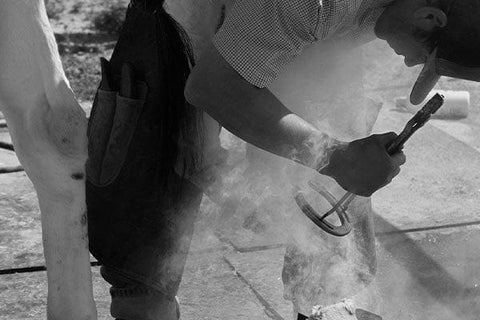
It seems simple; the farrier comes every 6-8 weeks, and most horses are acclimated to holding their feet up nicely while the farrier trims and dresses the hoof. In real life, things are not always this simple! Many horses have developed aversions to farriery, either due to inexperience or potentially a past negative event. Here are some tips to help things go smoothly for your farrier, who is working very hard!
It seems simple; the farrier comes every 6-8 weeks, and most horses are acclimated to holding their feet up nicely while the farrier trims and dresses the hoof. In real life, things are not always this simple! Many horses have developed aversions to farriery, either due to inexperience or potentially a past negative event. Here are some tips to help things go smoothly for your farrier, who is working very hard!
- Picking hooves daily is the single most effective way to get your horse to stand quietly. Daily habits make it easier for horses to understand, and for health reasons, you should be picking feet often to avoid thrush and identify any injuries or a nail/rock wedged in the foot!
- Make sure that your horse is not in pain; many horses are quiet and happy for the forelimbs but will kick or slam their hind feet down. A painful response to holding a limb up does not encourage a horse to allow farrier work easily. Make sure to have your veterinarian evaluate your horse if you notice a trend for one leg being more difficult to shoe or trim.
- Eliminate stressors in the horse’s environment as much as possible. Too often I see people take a nervous horse far away from any other horses, and of course, they are dancing and anxious. This makes it very difficult for the farrier to do a good job. Keep the farrier area close to other horses and safe, with no busy or cluttered areas where a horse could act up.
- Make sure your horse understands basic ground manners and moves away from pressure. Even 5-10 minutes of groundwork before your appointment can help to focus the horse on the handler. This serves a dual purpose for horses that are stiff. If you are not sure how to teach groundwork principles, find a qualified trainer in your area to help.
- There are times where sedation or calming supplements are the only way to safely get a horse’s feet trimmed or shod. For example, a rescue horse that is long overdue may need 2-3 cycles with sedation to get used to farrier work. Ideally, you can decrease the dose of sedation each time, either administered by a veterinarian or using prescribed Dormosedan gel. For horses that are anxious but not dangerous, a calming supplement may be a good option. VetCS Hemp Paste for horses is great for nervous types, as CBD works as an anxiolytic. Given 30 minutes before the farrier arrival, it can work wonders to make the farrier and horse happy!

With all these considerations, do remember that horses respond to people’s energy. If both the farrier and the handler are impatient and resort to rough corrections, the horse will become increasingly more difficult for farrier appointments. Setting a horse up for success in the training and handling you do in between every farrier appointment can help the horse feel comfortable and confident.












